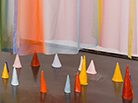Dormant Trajectories — an exhibition of works by Alicja Bielawska

Alicja Bielawska, born 1980 in Warsaw. A graduate of History of Art at University of Warsaw (2005) and of Fine Arts at Gerrit Rietveld Academie in Amsterdam (2009). In 2018, she commenced Inter-faculty Doctoral Studies at the Academy of Fine Arts in Gdańsk under the supervision of Prof. Katarzyna Józefowicz. She creates sculptures and drawings. Her works focus on the material sphere of the everyday life and the relationships between objects, interiors, and memories. Her materials of choice include textiles, metal, wood, and ceramics. In her works, she touches on the issues of relativity of our perception and the role of memory. She also includes elements of choreography and performance in her art. She is a recipient of the scholarship of the Minister of Culture and National Heritage (2012), Startstipendium Mondriaan Fonds (2012/13), and the Young Poland scholarship (2014). She has participated in artist residencies at Academie Schloss Solitude in Stuttgart (2014-2015) and Nida Art Colony (2016). In 2015, she was nominated for Views 2015 — the Deutsche Bank Award co-organized by Zachęta — National Gallery of Art in Warsaw, and in 2016, she received a nomination for Polityka Passport in the visual arts category. She lives and works in Warsaw.

Again and again, Alicja Bielawska's sculptures go wavy and straighten out. On the one hand, they outline the shape of the ceased activities, having accumulated all their earlier movement, with loops, slaloms, ripples and bends. On the other, they accommodate the potential for further manoeuvres.
The artist likes to think of her pieces as a kind of an alphabet — a set of forms availed for use in personal choreographies, waiting to become rearranged and endowed with new meanings. In this context, space becomes an archive of lines that have been delineated by viewers in motion. And although science demands that our organs of sight should be tools of objective analysis, that is calculating, rational and critical, eyes reunite with the body, so that, in unison with the sculptures, they could create short-lasting yet impassioned connections.
The objects reflect trajectories of viewers who walk around, slowing down their steps or perhaps retreating altogether, with inclined, skewed or raised heads. Various stands, axes, partitions, hoops, pennants, rails and ropes initiate dynamics that forms a treaty on gravity, wherein the weight of the cloths — as they hang down and turn inside out — is a way to express the fascination with the downward force that drives matter to earth, to another physical substance. Due to the ever-changing relationships between objects, which are moved by airflows induced by the viewers' bodies, the exhibition has no permanent spots — it seems to be swaying and spilling all around.
Curator — Marta Lisok







